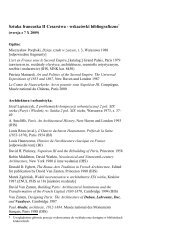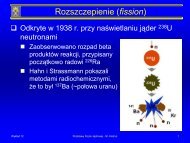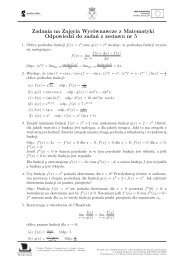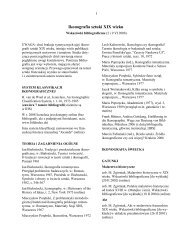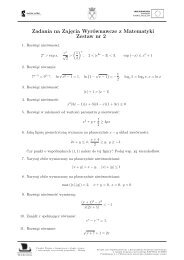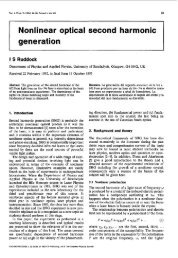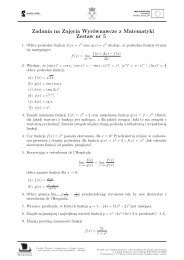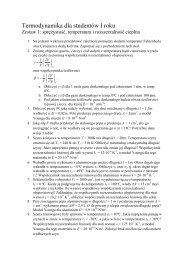Nucl. Instr. and Meth. A 565 (2006) 711
Nucl. Instr. and Meth. A 565 (2006) 711
Nucl. Instr. and Meth. A 565 (2006) 711
You also want an ePaper? Increase the reach of your titles
YUMPU automatically turns print PDFs into web optimized ePapers that Google loves.
714ARTICLE IN PRESSG. Ban et al. / <strong>Nucl</strong>ear <strong>Instr</strong>uments <strong>and</strong> <strong>Meth</strong>ods in Physics Research A <strong>565</strong> (<strong>2006</strong>) <strong>711</strong>–7247510ConcreteLead642819Magnet plate31mFig. 3. Layout of the experimental set-up including: 1—neutron beam collimator, 2—decay chamber, 3—beam stop, 4—multiwire proportionalchambers, 5—scintillator hodoscopes, 6—Mott scattering foil, 7—guiding field magnet, 8—fail-safe beam shutter, 9—Mylar window, 10—separatingMylar foil.producing gamma background. In average, only threephotons are produced per 10 4 captured neutrons ascompared to an almost 1:1 ratio for borated plastic, themost popular commercial neutron shielding material. Theinner walls of the collimator section are also covered by6 LiF polymer sheets. A 2:5 mm thick Mylar foil separatesthe helium-filled collimator box <strong>and</strong> decay chamber fromthe air gap occupied by the fail-safe beam shutter placedimmediately behind the beam line exit window. Thecollimator is surrounded by borated plastic, iron, lead<strong>and</strong> concrete blocks forming a wall which shields theexperimental area from the spin flipper section (Fig. 3).The name ‘‘decay chamber’’ was given to the section ofthe beam line which is ‘‘observed’’ by the electrondetectors. It is a 180 mm wide, 720 mm high, <strong>and</strong> 750 mmlong box made of Resocel 4 frames connecting twosymmetric parts of the Mott polarimeter. The decaychamber is coupled to the beam collimator through a300 mm long drift box. As in the case of the beamcollimator, the inner walls of the decay chamber (the framecomponents <strong>and</strong> the top <strong>and</strong> bottom) are covered with oneor two layers of 6 LiF polymer.After passing the decay chamber, neutrons enter thebeam stop section which is a 1300 mm long diverging boxcovered with 6 LiF shielding. The place where the beam isdumped contains four layers of this material. Calculationshave shown that the neutrons reflected from this beam stopincrease the neutron flux in the decay chamber by only10 ppm.The whole system consisting of the collimator, the driftbox, the decay chamber <strong>and</strong> the beam stop section is airtight, filled with helium with purity higher than 99% <strong>and</strong>kept at a slight overpressure against ambient air. Fig. 4presents a perspective view of the system. For clarity, thedetectors <strong>and</strong> the Mott scatterers were drawn semitransparent.4.2. Multiwire proportional chambersMWPC are used in the Mott polarimeter as electrontracking devices. They were built according to theexperience gained with a small prototype [5], a trackingdetector for electrons in the energy range 200–1000 keV.The amount of material which electrons have to traverse inthe detector should be as small as possible <strong>and</strong> the detectorshould provide an acceptable angular resolution. Moreover,the active part of the detector must be made withmaterials having the lowest possible Z in order to minimizeangular straggling <strong>and</strong> depolarization in multiple Coulombscattering processes.The optimal parameters found in that study were: (i)wire material: Ni/Cr alloy (80/20%), (ii) wire diameter:25 mm, (iii) spacing between anode wires: 5 mm, (iv) spacingbetween cathode wires: 2.5 mm, (v) distance between anode<strong>and</strong> cathode planes: 4 mm, (vi) gas mixture: 90% helium,5% <strong>Meth</strong>ylal 5 vapor, 5% isobutane, (vii) high voltage:1800 V. Anode <strong>and</strong> cathode wires are oriented perpendicularlygiving xy-information on the hit position.Using the above geometry parameters, two MWPCswere built with an active area of 500 500 mm 2 each. Eachchamber consists of five cathode–anode–cathode packetsstacked next to each other with 4 mm thick spacers inbetween. The chamber windows are made of 2:5 mm thickMylar foil. For protection, two extra planes of wires areinserted between the outer cathode planes <strong>and</strong> thewindows. These wires are kept at a voltage of about 20 V<strong>and</strong> can trigger an alarm <strong>and</strong> an emergency shutdownprocedure in case an imbalance between the inner <strong>and</strong>outer gas pressure occurs. Note that an imbalance of only 1per mille results in a force of 20 N on this fragile foil.All wire frames <strong>and</strong> spacers are made of Stesalit 6 glassfiber. They are sealed with 1.6 mm thick rubber gaskets <strong>and</strong>4 Micafil, UK.5 <strong>Meth</strong>ylal: C 3 H 8 O 2 .6 Stesalit AG, Switzerl<strong>and</strong>.
ARTICLE IN PRESSG. Ban et al. / <strong>Nucl</strong>ear <strong>Instr</strong>uments <strong>and</strong> <strong>Meth</strong>ods in Physics Research A <strong>565</strong> (<strong>2006</strong>) <strong>711</strong>–724 715Fig. 4. Perspective view of the beam guiding system. For clarity, the detectors <strong>and</strong> the Mott scatterers are drawn semi-transparent. 1—beam collimator,2—decay chamber, 3—beam stop. The support structure <strong>and</strong> guiding field magnets are omitted.equipped with commercial gas in <strong>and</strong> outlets. The gasmixture flow is kept at 20 l per hour (per detector).It should be noted that the 2:5 mm thick Mylar MWPCwindows are in no way tight for helium. Helium is thusexchanged between the MWPCs <strong>and</strong> the decay chamberdue to diffusion. However, Mylar is tight enough toprevent <strong>Meth</strong>ylal <strong>and</strong> isobutane from diffusing into thebeam section.4.3. Gas flow controlA gas system based on st<strong>and</strong>ard commercial flowmeters(tapered glass tube with a float) was built to mix helium,isobutane <strong>and</strong> <strong>Meth</strong>ylal. Since, at normal pressure,<strong>Meth</strong>ylal is liquid, its admixture is realized by passing awell-defined fraction of pure helium through a temperaturestabilized <strong>Meth</strong>ylal bubbler. Thus, the <strong>Meth</strong>ylal concentrationin the gas mixture can be controlled either by a changeof the helium flow through the bubbler or by a change ofthe <strong>Meth</strong>ylal temperature. This low cost solution suffersfrom sensitivity to small fluctuations of the input pressure,limiting the absolute accuracy of the mixture compositionto about 1%. To reduce this effect the application ofelectronic gas flow controllers is planned.4.4. Scintillator hodoscopesThe role of the plastic scintillator hodoscopes is twofold.They provide energy <strong>and</strong> crude hit position information forthe detected electrons as well as the time reference in thefast trigger logic <strong>and</strong> wire signal readout scheme. Eachhodoscope consists of six plastic scintillator 7 slabs with thedimensions 630 100 10 mm 3 , coupled on each end to aphotomultiplier 8 through short light guide adaptors.Scintillators <strong>and</strong> adaptors are wrapped with a thinaluminized Mylar foil <strong>and</strong> equipped with light emittingdiodes 9 (LED) placed in the center. LED flashes are usedfor monitoring the detector gain stability. Light tightness isprovided by thin polycarbonate foil. 10 The photomultipliersare mounted in tight compartments flushed with air,with a small overpressure to prevent diffusion of heliuminto the glass bulbs. They are shielded with m-metal againstthe stray field of the neutron spin guiding field magnets.4.5. Mott scattering foilThe Mott scattering target consists of about 1 mg=cm 2natural lead evaporated onto a 2:5 mm thick Mylarsubstrate <strong>and</strong> stretched over a 500 500 mm 2 large Resocelframe. For technical reasons the substrate consists of two250 mm wide strips. The lead uniformity in the longitudinaldirection is better than 7% while in the transverse directioncontinuous variations up to 20% are possible. The targetframes (two pieces) are mounted in special heliumfilledchambers placed on both sides of the polarimeter.7 Bicron B408.8 Photonis XP3330/B.9 LED Dielight.10 LOFO High Tech Film GmbH, Germany.
716ARTICLE IN PRESSG. Ban et al. / <strong>Nucl</strong>ear <strong>Instr</strong>uments <strong>and</strong> <strong>Meth</strong>ods in Physics Research A <strong>565</strong> (<strong>2006</strong>) <strong>711</strong>–724Fig. 5. Perspective view of the detection system <strong>and</strong> Mott target assembly. For clarity, the beam guiding elements <strong>and</strong> one side of the polarimeter aredrawn semi-transparent. 1—MWPC, 2—scintillator hodoscope, 3—Mott scattering foil (‘‘foil-out’’ position). The support structure <strong>and</strong> the guiding fieldmagnets are omitted.A remotely controlled change-over between the two workingpositions (‘‘foil-in’’ <strong>and</strong> ‘‘foil-out’’) is available. TheMott target chambers are s<strong>and</strong>wiched between the MWPCs<strong>and</strong> the scintillator hodoscopes as shown in Fig. 5.Front viewBSide viewB4.6. Guiding fieldThe neutron polarization has to be maintained in thebeam, including the segment observed by the detectors.The whole apparatus is enclosed in an electromagnet whichconstitutes also a convenient support structure for theexperiment. This magnet consists of two horizontal ironplates (200 100 1cm 3 ) connected with eight ‘‘legs’’(198 10 2cm 3 ) which support copper coils connected inseries to a DC power supply. The magnet produces avertical field of about 1 mT. In the volume occupied by theneutron beam <strong>and</strong> viewed by the polarimeter detectors thefield uniformity, defined as a tangent of the maximalangular departure of the field vector from the verticaldirection, tan y, is better than 0:01. This tolerance is inagreement with the precision of about 1% for the neutronpolarization measurement [13]. In the same region, the fieldmagnitude varies less than 5%.In order to improve the guiding field uniformity in thebeam collimator in front of the main magnet <strong>and</strong> toadiabatically guide the spins of the neutrons entering theyx1mFig. 6. Layout of the guiding field magnets. The shaded areas representsthe coils.Mott polarimeter a second, smaller magnet of similardesign was integrated in the shielding wall. The layout ofboth magnets is shown in Fig. 6.4.7. Readout electronicsThe electronic system of the detectors is an upscaledcopy of that developed for the prototype detector [5].Signals from both anode <strong>and</strong> cathode wires are acquired.yz
ARTICLE IN PRESSG. Ban et al. / <strong>Nucl</strong>ear <strong>Instr</strong>uments <strong>and</strong> <strong>Meth</strong>ods in Physics Research A <strong>565</strong> (<strong>2006</strong>) <strong>711</strong>–724 717For the cathode planes, only wires belonging to one planeper packet are actively read. The second plane is inactive.Moreover, the adjacent active wires are coupled into pairssince it is not possible to achieve a spatial resolution betterthan 5 mm due to the induced charge distribution (large hitclusters). The advantage of coupling the wires into pairsresides in the increase of pulse height <strong>and</strong> reduction of thenumber of electronic channels. After amplifying, shaping<strong>and</strong> discriminating, the wire signals undergo time analysiswith respect to the reference signal delivered by the fasttrigger circuit. Such time information allows a rough pulseheight selection useful in the centroid reconstruction ofoverlapping clusters [5].Another interesting feature of this electronic system is itsanalog multiplexer exploiting the multihit capability of theTDC module. 11 In this way, the total number of digitalchannels necessary for two chambers can be reduced from1920 to 384.The electronics used for the photomultipliers is ratherst<strong>and</strong>ard <strong>and</strong> uses custom-made boards. The 24 individualanode signals are first split in analog fan-outs. One branchis delayed <strong>and</strong> sent to charge sensitive ADCs. 12 The secondis fed to the fast trigger circuit after discrimination.Additionally, the time measurement with respect to thefast trigger reference is performed for all individual PM’swith the accuracy of 5 ns. One should note that thehodoscopes operate at high count rates ( 5 10 5 persecond, per hodoscope) so that time information is veryuseful for the reduction of r<strong>and</strong>om coincidences.4.8. Fast triggerUnder experimental conditions the background radiationconsists of scattered neutrons, secondary g-rays <strong>and</strong>electrons. This requires the inclusion of the informationfrom the wire chambers in the event selection process. Theelectrons originating from neutron decay which werebackscattered in the Mott analyzer foil, must traverse oneof the two wire chambers twice <strong>and</strong> the second one onlyonce before being detected in the plastic scintillator. Thisallows to use the wire hit multiplicity information todistinguish between ‘‘good events’’ (called here ‘‘V-tracks’’)<strong>and</strong> more frequent ‘‘single-track’’ events. The characteristicsignature of a ‘‘V-track’’ event is that the number of wireshit on the side of the scattering vertex is roughly two timeslarger than that on the opposite side. Since the wire hitmultiplicity information is not available for the hardwaretrigger, the final identification of the Mott scattering eventsis performed in the off-line analysis. On-line, instead, thehardware trigger utilizes the plane multiplicity signalswhich are constructed from the logic wire signals,separately for the anode <strong>and</strong> the cathode planes. Theyare available already 80 ns after the scintillator pulse. The‘‘V-track’’ c<strong>and</strong>idates are recognized by dem<strong>and</strong>ing a high11 LeCroy, Multihit TDC, model LRS 3377.12 LeCroy, Charge sensitive ADC, model LRS 4300B.plane multiplicity on both sides in coincidence with exactlyone scintillator hodoscope involved in the event. If thishappens, a master gate triggers the data acquisition system.All the scintillator signals appearing within a time windowof 80 ns <strong>and</strong> all the wire signals appearing within a timewindow of 400 ns are digitized <strong>and</strong> stored. The ‘‘singletrack’’c<strong>and</strong>idates are recognized as coincidences betweenthe high plane multiplicity in only one MWPC <strong>and</strong> thecorresponding hodoscope logic OR signal. The ‘‘singletrack’’events are stored at a rate prescaled by a factor of 2.The logic circuit realizing the above conditions has beendeveloped in the study of the prototype detector, for detailssee Ref. [5].4.9. Data acquisition <strong>and</strong> control systemsAll pulse digitizers used in the experiment are FERA 13compatible. The main stream of data is transported overthe FERA bus, der<strong>and</strong>omized in two VME hosted tripleport memory modules 14 <strong>and</strong> logged onto a Digital LinearTape device under control of a RIO2 controller 15 runningthe LynxOS real-time operating system. Data buffermanagement <strong>and</strong> monitoring utilities are performed withthe MBS data acquisition software 16 controlled from a PCrunning a Linux operating system. The maximal dataflow rate in the experiment reaches 1 MB/s, far belowthe throughput capacity of the system which approaches7 MB/s.All slow control tasks, including setting of high-voltagechannels, DC thresholds, monitoring <strong>and</strong> security feedbacks,as well as controlling of a mechanism for energycalibration, are organized around an industrial PCcomputer <strong>and</strong> programmed in the LabView 17 environment.5. Performance testsThe complete system was tested with the polarized coldneutron beam FUNSPIN. Tests addressed the trackingcapabilities of wire chambers with emphasis on the spatialresolution of the reconstructed Mott scattering vertex <strong>and</strong>on signal-to-background ratio.An important issue is the identification of electronsemitted in the neutron decay. This is performed bycomparing the measured energy distribution, after backgroundsubtraction, with the theoretical b-decay spectrum.From the decay asymmetry, it is possible to deduce theaverage polarization of neutrons within the angularacceptance of the Mott polarimeter, with a precisionadequate for the measurement of the R correlation. Thearrangement of detectors is, however, far from beingoptimal for this purpose.13 LeCroy, Fast Encoding <strong>and</strong> Readout Acquisition.14 CES, Triple Port Memory, model 8170.15 CES, RIO2 PowerPC based VME controller.16 MBS, Data acquisition package, GSI, Darmstadt.17 National Laboratories, LabView package for data acquisition.
718ARTICLE IN PRESSG. Ban et al. / <strong>Nucl</strong>ear <strong>Instr</strong>uments <strong>and</strong> <strong>Meth</strong>ods in Physics Research A <strong>565</strong> (<strong>2006</strong>) <strong>711</strong>–724Fig. 7. Display of a typical event. The size of dots representing wire hits is proportional to the pulse height. Dashed lines represent straight line fits to thecombination of clusters performed independently for two projections: yx—information from anode wires <strong>and</strong> zx—information from cathode wires. Thelength of the bar marking the hit scintillator slabs represents the acquired pulse height. The rectangles on the y- <strong>and</strong> z-axes indicate the neutron beamposition. The circles show the track segment matching regions.5.1. Reconstruction of electron tracks <strong>and</strong> scattering verticesThe first step in the reconstruction of the electron tracksis the recognition of wire hit clusters for two spatialprojections independently: yx—information from anodewires <strong>and</strong> zx—information from cathode wires. A typicalevent is shown in Fig. 7. Overlapping clusters are resolvedusing the pulse height information. Straight lines are thenfitted to the hit patterns in both projections using acombinatoric algorithm <strong>and</strong> the w 2 -criterion. The resultingelectron track segment c<strong>and</strong>idates are confronted with a setof conditions, including geometrical limits, matchingbetween track segments <strong>and</strong> matching with the scintillatorhit. According to the degree of fulfillment of the criteriaabove, the events are assigned suitable ‘‘quality weights’’for further analysis.If the track segments crossing is seen in both projections,further steps are taken to finally identify a Mott scatteringvertex of an electron originating in the beam volume: (i) thex-coordinates of the vertices, reconstructed with theinformation from anodes (xy-projection) <strong>and</strong> from cathodes(xz-projection), should match with each other withina given tolerance, (ii) the wire chamber opposite to the onesuspected to register a V-track should have detected onlyone track fitting to one arm of this V-track c<strong>and</strong>idate,(iii) the scintillator close to the V-track vertex must nothave detected an electron.Fig. 8 shows the distributions of x-coordinates of thereconstructed electron scattering vertices. In the upperpanel, the ‘‘foil-in’’ <strong>and</strong> ‘‘foil-out’’ measurements areplotted while the lower panel shows the difference betweenFig. 8. Distributions of x-coordinates of the reconstructed electronscattering vertices. Both, ‘‘foil-in’’ <strong>and</strong> ‘‘foil-out’’ measurements (upperpanel) as well as the difference between these (lower panel) are plotted.The arrows show the positions of the Pb-foils.
ARTICLE IN PRESSG. Ban et al. / <strong>Nucl</strong>ear <strong>Instr</strong>uments <strong>and</strong> <strong>Meth</strong>ods in Physics Research A <strong>565</strong> (<strong>2006</strong>) <strong>711</strong>–724 719Foil No. 1Foil No. 2250200200200y-coordinate (mm)1000-1001000-100150100-200-20050-200 -100 0 100 200z-coordinate (mm)-200 -100 0 100 200z-coordinate (mm)0Fig. 9. Surface density distributions of the reconstructed vertices of the Mott scattering from Pb, projected onto the plane occupied by the Mott target.these. The resulting distributions define the positionresolution to locate the Mott scattering foil. The asymmetrybetween the numbers of the reconstructed vertices onboth polarimeter sides can be traced back to the differencein the amount of the scatterer material, slightly differenteffective scintillator thresholds <strong>and</strong> unequal MWPCefficiencies. The small peaks seen in both ‘‘foil-in’’ <strong>and</strong>‘‘foil-out’’ spectra around x ¼180 mm are due toscattering on the inactive wire plane close to the MWPCwindow. Fig. 9 contains the density distributions ofreconstructed vertices of the Mott scattering from Pbnuclei projected onto the plane occupied by the Motttarget. The density variations reflect both the geometricalacceptance of the polarimeter <strong>and</strong> the varying surfacedensity of the target.5.2. Energy calibrationThe energy calibration of the plastic scintillator hodoscopesis performed using conversion electrons from a 207 Bisource. This source provides mono-energetic electrons ofseveral energies in the region of interest. Due to themodest resolution of plastic scintillators, only two energygroups can be distinguished around E 1 ¼ 503 keV <strong>and</strong>E 2 ¼ 995 keV. The calibration procedure is as follows: (i)Data is taken with the 207 Bi source moving slowly in frontof the wire chambers. In this way, any dependence of gainon the hit position can be traced <strong>and</strong> corrected for. (ii) Theelectron tracks are reconstructed from the wire chamberdata. (iii) The combined pulse height, g i ,(i ¼ 1; ...; 12—slab number) is defined in a st<strong>and</strong>ard way [12] as thegeometrical mean from the pulse heights c upi<strong>and</strong> c downi ofsignals recorded by the ‘‘up’’ <strong>and</strong> ‘‘down’’ photomultipliersattached to the scintillator slab <strong>and</strong> the energy groups, E ð1Þ<strong>and</strong> E ð2Þ , are identified. (iv) Knowing the hit position (fromthe extrapolated electron track) the position dependence ofthe gain is constructed for all detector slabs <strong>and</strong> for bothenergy groups, E ð1Þ <strong>and</strong> E ð2Þ , independently. The gainfunction, g i ðyÞ, is assumed to be a linear function of the‘‘deposited energy’’, E 0 , i.e. corrected for the energy lossobtained from look-up tables (the look-up tables areconstructed for particular geometry <strong>and</strong> material compositionin 10 keV steps; linear interpolation is applied forenergies between mesh points):g ð1Þi ðyÞ g ð2Þi ðyÞ qffiffiffiffiffiffiffiffiffiffiffiffiffiffiffiffiffiffiffiffiffiffiffiffiffiffiffiffiffiffiffiffiffiffiffiffiðyÞc ð1ÞupiðyÞc ð1Þdowni¼ 1a i ðyÞ ½E0ð1Þ b i ðyÞŠ; i ¼ 1; ...; 12,qffiffiffiffiffiffiffiffiffiffiffiffiffiffiffiffiffiffiffiffiffiffiffiffiffiffiffiffiffiffiffiffiffiffiffiffiðyÞc ð2ÞupiðyÞc ð2Þdowni¼ 1a i ðyÞ ½E0ð2Þ b i ðyÞŠ. ð3ÞThe position dependent gain coefficients a i ðyÞ <strong>and</strong> b i ðyÞ aredifferent for different scintillator slabs. They can becalculated from the above set of equations. Fig. 10 showsthe y-dependence of the gain coefficients a i , b i for onescintillator slab, together with the calibrated 207 Bi spectrumrecorded with the complete hodoscope.In order to determine the linearity of the detectorresponse, the procedure was repeated with the 207 Bi sourcecovered by energy degraders of various thicknesses. In theanalysis, the energy loss look-up tables were modifiedaccordingly. Fig. 11 demonstrates the relation between thepulse height <strong>and</strong> energy for one scintillator slab.5.3. Beta decay spectrumAfter the electron tracks are reconstructed <strong>and</strong> theenergy response of the plastic scintillators is calibrated,
ARTICLE IN PRESS720G. Ban et al. / <strong>Nucl</strong>ear <strong>Instr</strong>uments <strong>and</strong> <strong>Meth</strong>ods in Physics Research A <strong>565</strong> (<strong>2006</strong>) <strong>711</strong>–724Fig. 10. Left: y-dependence of the gain coefficients a (open squares) <strong>and</strong> b (full squares) for the scintillator slab no. 4 from the second hodoscope. The solidline is plotted only to guide eye. Right: calibrated 207 Bi spectra recorded with the complete hodoscope no. 2 sorted according to the path length of thedetected electron.Energy (keV)12001000800600400Hodoscope 2, Scintilator 4, -112 < y < -56 mm1µm Pb + 2.5 µm Mylar2 x 100 µm Al1 µm Pb + 2.5 µm Mylar1 x 100 µm Al1 x 100 mµ Al3 x 100 mµ Al200Linear fit00 50 100 150 200 250c 1 c 2 (channel)Fig. 11. Linearity response of the scintillator slab no. 4 from the secondhodoscope. The symbols correspond to peak positions measured withdifferent degrader sets <strong>and</strong> for 112oyo 56 mm. The solid line is thelinear least square fit to the data.single track events are selected from the data stream. Twoadditional constraints significantly reduce the background:(i) The backward extrapolated tracks should not crossthe inactive parts of the set-up, like frames or supports,which are observed to be substantial background sources.(ii) Neither the hodoscope nor the wire chamber oppositeto the side which has detected a single track event recordedsignals (veto). The hodoscope veto signals are searched forin the vicinity of the crossing point of the extrapolatedtrack on the hodoscope plane. The interval Dz ¼ 140 mmrespects the segmentation of the hodoscope in z-direction(100 mm). The events selected with the above conditionsare then subdivided into two groups: (i) ‘‘from-beam’’—theextrapolated tracks cross the volume occupied by theneutron beam <strong>and</strong> (ii) ‘‘outside-of-beam’’—extrapolatedtracks do not cross the neutron beam. Furthermore, theevents are sorted for different track angles (with respect tothe direction of the neutron polarization) which lead todifferent electron path length in the detector medium. Thespectra resulting from the subtraction of the ‘‘from-beam’’<strong>and</strong> ‘‘outside-of-beam’’ histograms are displayed in Fig. 12.Since the acceptances for ‘‘from-beam’’ <strong>and</strong> ‘‘outside-ofbeam’’events are not identical, before subtracting, thecorresponding spectra were normalized so that they matchat the high-energy end. It is assumed that the shape ofbackground for ‘‘from-beam’’ <strong>and</strong> ‘‘outside-of-beam’’events is identical for the energies above the neutron decayendpoint. It is expected that the same holds for the lowerenergyregion where the direct background measurement isimpossible. Indirect confirmation of this assumption can bedrawn from a comparison of the experimental b-spectrumwith the theoretical prediction. In Fig. 12, the solid linescorrespond to the b-spectrum with instrumental energysmearing <strong>and</strong> a low-energy cut due to energy loss includedin the Monte-Carlo simulation. On the high-energy side,the comparison is very satisfactory: the slope is wellreproduced. The disagreement at the low energy isattributed to the electronic threshold which was notincluded in the simulations. Note that the low-energy slopeis nearly identical for all three path length groups. Becauseof the strong position dependence of the signal amplitudein individual light readout channels, the observed thresholdsare rather smooth.5.4. Beta decay asymmetryIt follows from Eq. (1) that the rate of electrons emittedat an angle y with respect to the neutron polarizationvector isNðyÞ /1 þ PA p eE ecos y (4)
ARTICLE IN PRESSG. Ban et al. / <strong>Nucl</strong>ear <strong>Instr</strong>uments <strong>and</strong> <strong>Meth</strong>ods in Physics Research A <strong>565</strong> (<strong>2006</strong>) <strong>711</strong>–724 72180006000ExperimentSimulations1500010000ExperimentSimulationsCounts40002000Path Length 265-276 mm5000Path Length 276-306 mm000 500 1000Energy (keV)0 500 1000Energy (keV)20000800015000ExperimentSimulations6000Counts10000Path Length 306-374 mm400050002000000 500 1000Energy (keV)0 200 400 600 800Energy (keV)Fig. 12. Energy spectra of electrons constructed by subtraction of the ‘‘from-beam’’ <strong>and</strong> ‘‘outside-of-beam’’ histograms for three ranges of the electronpath length. The solid lines correspond to the theoretical prediction. In the right-lower panel, the experimental spectra are compared after normalization atthe right tail.where P is the neutron polarization <strong>and</strong> A is the neutrondecay asymmetry parameter. The product of P <strong>and</strong> A canbe deduced from the rate asymmetry A obtained for thetwo neutron polarization states, þP <strong>and</strong> P, at anglesdifferent from p=2:AðyÞ Nþ NN þ þ N¼ PA p ecos y (5)E ewhere N þ ; N are the count rates corresponding to thepolarization states þP; P, respectively. In Eq. (5), therates of ‘‘emitted’’ electrons can be replaced by the rates of‘‘detected’’ electrons eN þ ; eN as the detection efficiencyshould not change with flipping of the neutron polarization.Integrating over energy, the asymmetry calculatedfrom background corrected electron spectra, collectedseparately for the two neutron polarization states, leadsto the average asymmetry which is a linear function ofhcos yi (the experimental average over the arbitrarilychosen cos y bin):fA 0 AðyÞ E Ze¼p edE eE ep eeN þ eNeN þ þ eN ¼ PA hcos yi. (6)PA n cosθ0.060.040.020.00-0.02-0.04-0.06P = 0.86 +/- 0.05(A n = 0.1173 +/- 0.0013)Exp. datalinear fit-0.4 -0.2 0.0 0.2 0.4cos θFig. 13. Distribution of the energy integrated experimental neutron decayasymmetry as a function of cos y. The straight line results from a linearleast square fit to the data.The variation of fA 0 is presented in Fig. 13 with a straightline fit. One should note that the effect of incomplete spinflipping [13] has been neglected since it has only a smallimpact on the result at this early analysis stage.
724ARTICLE IN PRESSG. Ban et al. / <strong>Nucl</strong>ear <strong>Instr</strong>uments <strong>and</strong> <strong>Meth</strong>ods in Physics Research A <strong>565</strong> (<strong>2006</strong>) <strong>711</strong>–724[6] J. Sromicki, M. Allet, K. Bodek, W. Hajdas, J. Lang, R. Mu¨ller, S.Navert, O. Naviliat-Cuncic, J. Zejma, W. Haeberli, Phys. Rev. C 53(1996) 932;R. Huber, J. Lang, S. Navert, J. Sromicki, K. Bodek, St. Kistryn,J. Zejma, O. Naviliat-Cuncic, E. Stephan, W. Haeberli, Phys. Rev.Lett. 90 (2003) 202301.[7] N. Sherman, Phys. Rev. 103 (1956) 1601.[8] J. Sromicki, <strong>Nucl</strong>. <strong>Instr</strong>. <strong>and</strong> <strong>Meth</strong>. A 440 (2000) 609.[9] S. Agostinelli, et al., <strong>Nucl</strong>. <strong>Instr</strong>. <strong>and</strong> <strong>Meth</strong>. A 506 (2003) 250.[10] M. Kuźniak, M.Sc. Thesis, Jagiellonian University, Cracow, 2004,arXiva nucl-ex/0406033.[11] K. Bodek, P. Boeni, Ch. Hilbes, J. Lang, M. Lasakov, M. Luethy,St. Kistryn, M. Markiewicz, E. Medvedev, V. Pusenkov, A.Schebetov, A. Serebrov, J. Sromicki, A. Vassiljev, Neutron News 3(2000) 29.[12] W.R. Leo, Techniques for <strong>Nucl</strong>ear <strong>and</strong> Particle Physics Experiments:A How-To Approach, second ed., Springer, 1994, ISBN: 0387572805.[13] J. Zejma, G. Ban, M. Beck, A. Bia"ek, K. Bodek, G. Frei, Ch. Hilbes,G. Kuehne, P. Gorel, K. Kirch, St. Kistryn, A. Kozela, M. Kuz´niak,A. Linroth, O. Naviliat, J. Pulut, N. Severijns, E. Stephan, <strong>Nucl</strong>.<strong>Instr</strong>. <strong>and</strong> <strong>Meth</strong>. A 539 (2005) 622.[14] M. Kuz´niak, et al., to be published.



